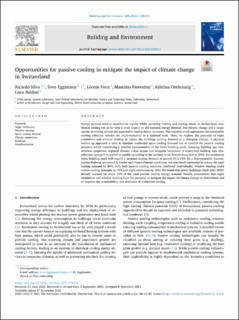Please use this identifier to cite or link to this item:
https://doi.org/10.21256/zhaw-23565Full metadata record
| DC Field | Value | Language |
|---|---|---|
| dc.contributor.author | Silva, Ricardo | - |
| dc.contributor.author | Eggimann, Sven | - |
| dc.contributor.author | Fierz, Léonie | - |
| dc.contributor.author | Fiorentini, Massimo | - |
| dc.contributor.author | Orehounig, Kristina | - |
| dc.contributor.author | Baldini, Luca | - |
| dc.date.accessioned | 2021-11-29T09:12:40Z | - |
| dc.date.available | 2021-11-29T09:12:40Z | - |
| dc.date.issued | 2021-11 | - |
| dc.identifier.issn | 0360-1323 | de_CH |
| dc.identifier.issn | 1873-684X | de_CH |
| dc.identifier.uri | https://digitalcollection.zhaw.ch/handle/11475/23565 | - |
| dc.description.abstract | Energy systems need to decarbonize rapidly whilst satisfying heating and cooling needs. In Switzerland, residential cooling has so far only a small impact on the national energy demand, but climate change and a larger uptake of cooling devices are expected to lead to future increases. This requires novel approaches for sustainable cooling solutions suitable for implementation at a national scale. Here, we explore the potential of night ventilation and window shading to reduce the buildings cooling demand in a changing climate. A physical bottom-up approach is used to simulate the residential space cooling demand and to identify the passive cooling potential whilst considering a detailed representation of the Swiss building stock, featuring building age, construction properties, regional climate, urban layout and occupant behaviour. A supervised building type classification approach is applied to enable up-scaling to the national level. Results show that in 2050, the residential Swiss building stock will require a national cooling demand of around 10.2 TWh for a Representative Concentration Pathway scenario 4.5. Under such future climatic conditions, we simulated a potential to reduce the total cooling demand by 84%, with both passive cooling solutions combined. Individually, window shading could reduce it by 71% and night ventilation by 38%. We found that newer buildings (built after 2000) already account for about 50% of the total current cooling energy demand. Results demonstrate that night ventilation and window shading have the potential to mitigate the impact of climate change in Switzerland and to improve the sustainability and resilience of residential cooling. | de_CH |
| dc.language.iso | en | de_CH |
| dc.publisher | Elsevier | de_CH |
| dc.relation.ispartof | Building and Environment | de_CH |
| dc.rights | http://creativecommons.org/licenses/by/4.0/ | de_CH |
| dc.subject | Night ventilation | de_CH |
| dc.subject | Window shading | de_CH |
| dc.subject | Space cooling demand | de_CH |
| dc.subject | Climate adaptation | de_CH |
| dc.subject | Building | de_CH |
| dc.subject | Decarbonisation | de_CH |
| dc.subject.ddc | 620: Ingenieurwesen | de_CH |
| dc.title | Opportunities for passive cooling to mitigate the impact of climate change in Switzerland | de_CH |
| dc.type | Beitrag in wissenschaftlicher Zeitschrift | de_CH |
| dcterms.type | Text | de_CH |
| zhaw.departement | Architektur, Gestaltung und Bauingenieurwesen | de_CH |
| zhaw.organisationalunit | Institut Bautechnologie und Prozesse (IBP) | de_CH |
| dc.identifier.doi | 10.1016/j.buildenv.2021.108574 | de_CH |
| dc.identifier.doi | 10.21256/zhaw-23565 | - |
| zhaw.funding.eu | No | de_CH |
| zhaw.issue | 108574 | de_CH |
| zhaw.originated.zhaw | Yes | de_CH |
| zhaw.publication.status | publishedVersion | de_CH |
| zhaw.volume | 208 | de_CH |
| zhaw.publication.review | Peer review (Publikation) | de_CH |
| zhaw.author.additional | No | de_CH |
| zhaw.display.portrait | Yes | de_CH |
| Appears in collections: | Publikationen Architektur, Gestaltung und Bauingenieurwesen | |
Files in This Item:
| File | Description | Size | Format | |
|---|---|---|---|---|
| 2021_Silva-etal_Passive-cooling-opportunities-Switzerland.pdf | 17.11 MB | Adobe PDF |  View/Open |
Show simple item record
Silva, R., Eggimann, S., Fierz, L., Fiorentini, M., Orehounig, K., & Baldini, L. (2021). Opportunities for passive cooling to mitigate the impact of climate change in Switzerland. Building and Environment, 208(108574). https://doi.org/10.1016/j.buildenv.2021.108574
Silva, R. et al. (2021) ‘Opportunities for passive cooling to mitigate the impact of climate change in Switzerland’, Building and Environment, 208(108574). Available at: https://doi.org/10.1016/j.buildenv.2021.108574.
R. Silva, S. Eggimann, L. Fierz, M. Fiorentini, K. Orehounig, and L. Baldini, “Opportunities for passive cooling to mitigate the impact of climate change in Switzerland,” Building and Environment, vol. 208, no. 108574, Nov. 2021, doi: 10.1016/j.buildenv.2021.108574.
SILVA, Ricardo, Sven EGGIMANN, Léonie FIERZ, Massimo FIORENTINI, Kristina OREHOUNIG und Luca BALDINI, 2021. Opportunities for passive cooling to mitigate the impact of climate change in Switzerland. Building and Environment. November 2021. Bd. 208, Nr. 108574. DOI 10.1016/j.buildenv.2021.108574
Silva, Ricardo, Sven Eggimann, Léonie Fierz, Massimo Fiorentini, Kristina Orehounig, and Luca Baldini. 2021. “Opportunities for Passive Cooling to Mitigate the Impact of Climate Change in Switzerland.” Building and Environment 208 (108574). https://doi.org/10.1016/j.buildenv.2021.108574.
Silva, Ricardo, et al. “Opportunities for Passive Cooling to Mitigate the Impact of Climate Change in Switzerland.” Building and Environment, vol. 208, no. 108574, Nov. 2021, https://doi.org/10.1016/j.buildenv.2021.108574.
Items in DSpace are protected by copyright, with all rights reserved, unless otherwise indicated.